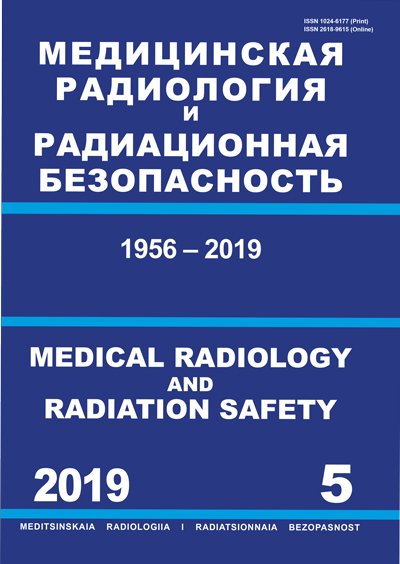Tomsk, Russian Federation
Tomsk, Russian Federation
Tomsk, Russian Federation
Tomsk, Russian Federation
National Research Tomsk Polytechnic University (Deputy Director)
Tomsk, Russian Federation
CSCSTI 76.03
CSCSTI 76.33
Russian Classification of Professions by Education 14.04.02
Russian Classification of Professions by Education 31.06.2001
Russian Classification of Professions by Education 31.08.08
Russian Classification of Professions by Education 32.08.12
Russian Library and Bibliographic Classification 51
Russian Library and Bibliographic Classification 534
Russian Trade and Bibliographic Classification 5708
Russian Trade and Bibliographic Classification 5712
Russian Trade and Bibliographic Classification 5734
Russian Trade and Bibliographic Classification 6212
Purpose: To study the features of the distribution and removal of a new radiopharmaceutical (RPH) on the basis of a labeled 99mTc glucose derivative for radionuclide diagnostics of oncological diseases in the body of experimental animals. Material and methods: The main stage of the study was performed on 65 mature conventional outbred white rats and 9 rabbits of the Soviet Chinchilla breed. To study the dynamics of changes in the concentration of the studied RPH in the blood plasma and its distribution in the main organs and tissues, as well as to study the metabolic features of the drug and its excretion, the RPH studied was administered intravenously, once in activity of 20 MBq. Multiple introduction of the RPH was performed in order to study the cumulative properties of the study drug, and to elucidate the possibilities of predicting the cumulation processes from the data obtained with a single administration of RPH. For this purpose, intravenous RPH was administered at the same time 1 time / day for 5 days, at a dose of 20 MBq. To confirm the theory of linearity of the pharmacokinetics of the RFP studied, three groups of laboratory animals received the drug in three activity levels – 10, 20 and 40 MBq were used. After euthanasia, the animals were autopsied and removed the necessary organs and tissues. The prepared and washed organs were placed in tubes for further radiometry in order to study the concentrations of the RPH in the bioassay. Results: It has been established that the RPH being studied practically does not accumulate in the main organs and tissues, accumulating mainly in the kidneys and bladder. The main organs of elimination of the test drug are the kidneys, and the main excreta are urine. The half-life of the drug from the blood was 10 minutes. Pharmacokinetics of the drug is linear and does not depend on the administered activity, and the drug itself does not possess cumulative properties. Conclusion: A study of the pharmacokinetics of the RPH 99mTc-1-Thio-D-glucose showed that the preparation possesses optimal properties for the diagnostic agent. The drug stably does not accumulate in the main organs and tissues, which allows it to be reused, for example at the stages of dynamic observation of cancer patients.
radiopharmaceutical, pharmacokinetics, technetium-99m, labeled glucose
Введение
По экспертным оценкам, потребность населения России в РФП удовлетворяется не более чем на 1–3 % [1, 2]. Как известно, наибольшее распространение в онкологии получили РФП на основе производных глюкозы [3, 4]. Существуют различные производные глюкозы, меченные радионуклидами 18F, 11С и другие. В настоящее время в России при позитронной эмиссионной томографии (ПЭТ) используется РФП 2-фтор-2-дезокси-D-глюкоза (18F-ФДГ), содержащий позитронно-излучающий радионуклид фтор-18, для диагностики опухолей, выявления метастазов и оценки эффективности противоопухолевой терапии. Несмотря на высокую диагностическую информативность ПЭТ с использованием 18F-ФДГ, широкое применение этого метода ограничено из-за его высокой стоимости, а также из-за недостаточного количества ПЭТ-центров.
1. Chernov V, Sinilkin I, Choynzonov E, Zelchan R, Medvedeva A, Bragina O. Comparative evaluation of 99mTc-Al2O3 and 99mTc-fitat nanocolloids for sentinel lymph nodes, visualization in patients with cancer of larynx and hypopharynx. Europ J Nucl Med Mol Imaging. 2015;42:704.
2. Chernov VI, Sinilkin IG, Zelchan RV, Medvedeva AA, Bragina OD, Varlamova NV et al. Experimental study of 99mTc-aluminum oxide use for sentinel lymph nodes detection. AIP Conf Proc. 2016;1760.020012.
3. Chernov VI, Medvedeva AA, Sinilkin IG, Zelchan RV, Bragina OD, Skuridin. Experience in the development of innovative radiopharmaceuticals in Tomsk Research Institute of Oncology. Siberian Oncol J. 2015;2:45-7. (in Russian).
4. Zeltchan R, Medvedeva A, Sinilkin I, Chernov V, Bragina O, Dergilev A. Experimental study of radiopharmaceuticals based on technetium-99m labeled derivative of glucose for tumor diagnosis. IOP Conf Series: Materials Sci Eng. 2016;135(1):012054.
5. Welling MM, Alberto R. Performance of a 99mTc-labelled 1-thio-beta-D-glucose 2,3,4,6-tetra-acetate analogue in the detection of infections and tumors in mice: a comparison with [18F] FDG. Nuc. Med Commun. 2010;31(3):239-48.
6. Stasyuk ES, Skuridin VS, Ilina EA, Varlamova NV, Zelchan RV, Nesterov EA, et al. Development of new radiopharmaceutical based on 5-thio-d-glucose labeled technetium-99m. IOP Conf Series: Materials Sci Eng. 2016;135(1):012044.
7. Doroshenko A, Chernov V, Medvedeva A, Sinilkin I, Dergilev A, Zelchan R, et al. The first experience of using 99mTc-Al2O3 for the detection of sentinel lymph nodes in breast cancer. IOP Conf Series: Materials Sci Eng. 2016;135(1):012011.
8. Federal Target Program “Development of the pharmaceutical and medical industry of the Russian Federation for the period until 2020 and beyond”. Preclinical studies of radiopharmaceutical on the basis of labeled 99mTc glucose derivative for radionuclide diagnostics of oncological diseases. State contract No. 14.N08.11.0033 of 19.05.2015. (in Russian).





